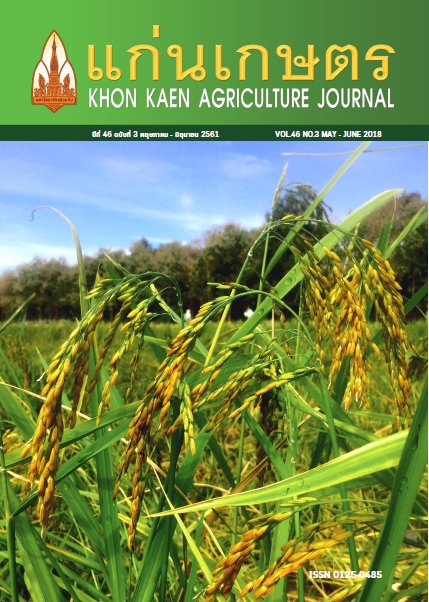The effect of trim conditions and massaging times on quality characteristics of Som-fug from tilapia trim meat
Main Article Content
บทคัดย่อ
Production of Som-fug, a Thai traditional fermented fish sausage, from under-utilized tilapia trim meat, was explored. The objective of this study was to investigate conditions of tilapia trim meat (un-minced and minced) and massaging times (5 and 10 minutes) for Som-fug production. Uncooked Som-fug samples from 4 treatments including 1) un-minced trim meat and 5 minute massaging (UM-5), 2) un-minced trim meat and 10 minute massaging (UM-10), 3) minced trim meat and 5 minute massaging (M-5), and 4) minced trim meat and 10 minute massaging (M-10), were analyzed for total plate count (TPC), yeast and mold (YM), lactic acid bacteria (LAB), pH, and sensorial acceptability. Baked Som-fug samples were also evaluated for sensorial acceptability. The study showed that conditions of tilapia trim meat and massaging times did not affect the TPC, YM, LAB, pH, sensorial acceptability scores of uncooked samples (interior color, odor, and overall acceptability), and sensorial acceptability scores of baked samples (odor, mouth-feel texture, flavor, and overall acceptability). However, the conditions and the massaging times affected appearance and hand-feel texture scores of uncooked samples, as well as appearance and interior color scores of baked samples. For 5 minute massaging time, minced tilapia trim meat (M-5) yielded the better sensorial scores, compared to un-minced tilapia trim meat (UM-5). For 10 minute massaging time, the minced (M-10) and the un-minced (UM-10) yielded the same sensorial results. On average, 10 minute massaging produced better sensorial scores, compared to 5 minute massaging. If 10 minute massaging is employed, either un-minced or minced tilapia trim meat can be used for Som-fug production. Either UM-10 or M-10, therefore, benefited Som-fug production from tilapia trim meat.
Article Details
เอกสารอ้างอิง
Arboix, J. A. 2014. Cooked ham. P. 82-86. In: M. Dikeman and C. Devine. Encyclopedia of Meat Sciences. 2ndEdition. Elsevier, NY.
Chiou, T. and J. Huang. 2004. Biochemical changes in the abdominal muscle of mud crab Scylla serrata during storage. Fish. Sci. 70: 167–173.
Chuaphohak, P. 2006. Local Products from Aquatic Animals. Kasetsart University Press, Bangkok (Translated from Thai).
Daengprok, W., W. Garnjanagoonchorn, and N. Mine. 2002. Fermented pork sausage fortified with commercial or hen eggshell calcium lactate. Meat Sci. 62: 199-204.
Gawborisut, S., K. Huaisan, and P. Srisakultiew. 2014. Technologiesfor producing value-added food and leather commodities from tilapia processing industry by-products: production of fish ham, essence of fish, and Som-fug from tilapia trim meat. Full report project No. 2557A1030304. National Research Council of Thailand, Bangkok (Translated from Thai).
Homehong, S. 2014. Stability of frozen reduced salt, free phosphate emulsion product derived from Nile tilapia (Oreochromis niloticus Linn.) fillets and its by-product assed with rice brain peptides. M. S. Thesis. Khon Kaen University, Khon Kaen (Translated from Thai).
Knipe, C. L. 2014. Tumblers and massagers. P. 143-146. In: M. Dikeman and C. Devine. Encyclopedia of Meat Sciences. 2nd Edition. Elsevier, NY.
Kongkiattikajorn, J. 2015. Potential of starter culture to reduce biogenic amines accumulation in Som-fug, a Thai traditional fermented fish sausage. J. Ethnic Food. 2: 186-194.
Meilgaard, M., G. V. Civille, and B. T. Carr. 1991. Sensory Evaluation Techniques. CRC Press Inc., Boca Raton, FL.
Morton, R. D. 2001. Aerobic plate count. P. 63-67. In: F.D. Downes and K. Ito. Compendium Methods for the Microbiological Examination of Food. 4th Edition. American Public Health Association (APHA), Washington, D.C.
National Research Council of Thailand. 1982. Thai Traditional Fermented Food: Animal Meat Fermented Food Fish. National Research Council of Thailand, Bangkok.
Nurit, K. 2015. Production and trade of tilapia and tilapia products in 2015. Fisheries Economics Bureau, Department of Fisheries, Ministry of Agriculture and Cooperatives, Thailand. https://goo.gl/4A2bEq. (Translated from Thai). Accessed 3 Jan 2017.
Paludan-Müller, C., H. H. Huss, and L. Gram. 1999. Characterization of lactic acid bacteria isolated from a Thai low-salt fermented fish product and the role of garlic as substrate for fermentation. Int. J. Food Microbiol. 46: 219–229.
Poowakanjana, S., S. G. Mayer, and J. W. Park. 2012. Optimum chopping conditions for Alaska pollock, Pacific whiting, and threadfin bream surimi paste and gel based on rheological and Raman Spectroscopic analysis. J. Food Sci. 77 (Nr. 4): E88-E97.
Prechawat, N. 2015. Tilapia products and price (personal communication in Thai). Sale Representative, Grobest Frozen Food, Grobest Corporation Ltd., Thailand.
Riebroy, S., S. Benjakul, W. Visessanguan, K. Kijrongrojana, and M. Tanaka. 2004. Some characteristics of commercial Som-fug produced in Thailand. Food Chem. 88: 527-535.
Riebroy, S., S. Benjakul, W. Visessanguan, K. Kijrongojana, and M. Tanaka. 2007. Changes during fermentation and properties of Som-fug produced from different marine fish. J. Food Process Preserv. 31: 751-770
Suthipan, S. 2011. By-product from tilapia fillet processing (personal communication in Thai). Sale Representative, Grobest Frozen Food, Grobest Corporation Ltd., Thailand. Thai Industrial Standards Institute. 2012. Community Products Standard No. 475/2547: fermented fish sausage (Esan style).
Thai Industrial Standards Institute, Ministry of Industry, Thailand (Translated from Thai).
Visessanguan, W., Benjakul, S., Smitinont, T., Kittikun, C., Thepkasikul, P., & Panya. A. (2006). Changes in microbiological, biochemical and physico-chemical properties of Nham inoculated with different inoculum levels of Lactobacillus curvatus. LWT- Food Science and Technology, 39, 814–826.
Zochowska-Kujawska, J., K. Lachowicz, M. Sobczak, L. Gajowiecki, M. Kotowicz, A. Zych, D. Medrala. 2007. Effects of massaging on hardness, rheological properties, and structure of four wild boar muscles of different fiber type content and age. Meat Sci. 75: 595-602.


